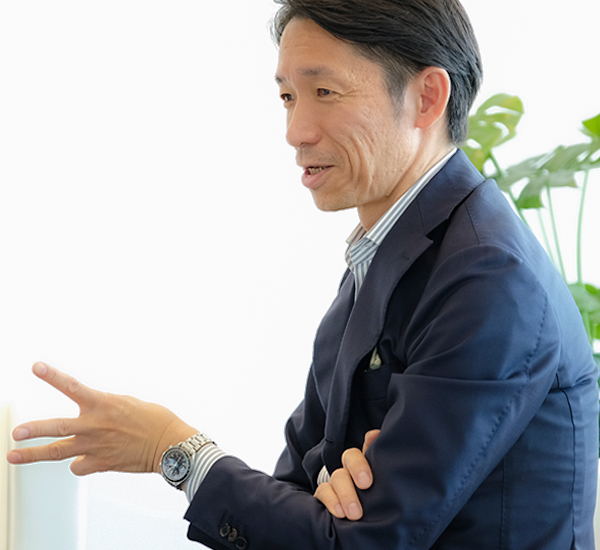
Creating a New Spatial Value with 5G x XR
Recently, there has been a rising interest in fifth-generation mobile communication systems (5G). KDDI Digital Design (KDI), a joint venture between KDDI and Nomura Research Institute (NRI), which supports digital transformation (DX) for clients, believes that combining 5G with XR technology, which is a generic term for virtual reality (VR), augmented reality (AR), and mixed reality (MR), will lead to new value creation. We asked Hirofumi Tatematsu of KDI and Shingo Mochimaru of NRI, who are familiar with the trends in XR technology, about its potential.
XR is Leading in the Entertainment Field
The use of XR technology seems to be increasing. Could you please give us some examples?
The most obvious one is "Pokémon GO", a smartphone game. It uses a technology that synthesizes and displays artifacts (pocket monsters) in the space users are looking at, using location data and AR. At present, the introduction of XR is leading in the entertainment field, such as games and watching sports, but experimental trials have also begun in areas such as telemedicine and technology transfer within factories. IKEA, a major furniture manufacturer, offers a service that allows you to visualize how your purchases would look by placing the selected furniture in your room on the smartphone application screen.
Could you tell us the background behind the accelerated introduction?

Since around 2017, Apple and Google have provided XR development platforms to developers and also promoted the development of related applications. As a result, the development of XR games took off. One of the major reasons behind the increase in usage of XR is that the information processing capability of devices has improved significantly and the time required to display images has been reduced. However, it is not yet in real-time, as there is a slight delay in the display. However, with the spread of 5G, the speed of information transmission will be accelerated and this delay will become imperceptible in everyday life. We can expect further uses such as watching sports by combining different viewpoints and playing e-sport matches in remote areas.
Every Company is in the Process of Learning by Doing
Will XR extend to fields other than entertainment?
I believe that it can be used in all types of industries. And currently, all companies are searching for ways to add value to their services using XR. Tech companies are challenging themselves by developing software using XR while major telecommunications carriers are conducting demonstration tests to bring them into the business. For example, KDDI is implementing the Shibuya Entertainment × Technologies Promotion Project in collaboration with the Shibuya City Tourism Association and other organizations. We aim to boost the momentum of XR by building a platform where various companies and organizations can participate to make the city attractive using XR, through activities such as digitally updating the city landscape or providing directions to event venues with an AR map.
What is the key to promoting its utilization?

In addition to communication environments such as the above, it is important to improve the devices. Currently, the use cases are limited as XR requires smartphones and VR lenses. For example, the mixed reality glasses "Nreal Light" developed by a Chinese manufacturer looks like a pair of normal sunglasses, but it is extremely lightweight and can directly superimpose XR images over real-world views. In the future, the use cases of XR will expand further with the advent of devices with XR and communication functions that can be retrofitted to existing glasses. These can be called the XR versions of Walkman. We can expect innovative services to emerge, transcending time and geographical constraints.
How can we overcome the constraints?
In short, there is a possibility that we can provide new services by transcending space using 5G and XR, which was not possible until now. For example, even if specialized medical staff cannot be sent to a disaster-hit area, if we can only send a high-performance camera to the site that can send high-precision images through 5G, it will be possible for remote medical personnel to determine the severity of injuries and provide directions on their treatment through XR. Efforts are already being made for this at the demonstration level. To take another example, in schools with fewer students, it might be difficult to carry out group activities. For instance, there may not be enough people in the brass band group or there may be no instructor. In such cases, 5G and XR would make it technically possible for brass band clubs from multiple schools to play together from their respective locations, under the direction of an instructor in another location.
Expectations from Business Models that can Change Spatial Value
The benefits of urban agglomeration can be enjoyed everywhere.
I think that the relationship between the cities and the rural areas will also change significantly. Currently, concerts by popular artists are held only in major cities to attract large audiences. As an effort to revitalize rural areas, it might be good to let the audience in big cities have a much cheaper live experience with XR devices. Meanwhile, with the artists performing at rural venues rather than at big venues in major cities, the audience will get a different concert experience. It will be possible to receive higher prices, while wealthier people will visit rural areas and experience the unique food, nature, travel, etc. of the local region. In recent years, gastronomy tourism, where people enjoy food culture rooted in local areas, has gained popularity worldwide. Artists will also appreciate the opportunity to enjoy the food culture and sights of Japanese regions other than big cities. In other words, the benefits of urban agglomeration, such as attracting a large number of spectators, can be added to the advantages of rural areas.
Experiences that could only be found in urban areas can now be realized in rural areas, transcending space. This is a new approach to regional revitalization.
That's right. What's particularly interesting is that new space value can change economic values and business models. Since the time of ancient Greece and Rome, cities have been the place that created higher economic value, but there is a possibility that the value of such spaces will change. Those who can create higher added value will not have to be bound by the functions and space of large cities. For example, it may be possible to provide medical services even with highly skilled doctors being located in rural areas and patients and facilities in cities. In this way, it is possible that people who were previously able to get high rewards only in big cities will move to live in rural areas, as a result of which physical services such as restaurants will come up and economic activities will be given a boost. Although there are a variety of ideas, the first step is to redefine the spatial value based on XR and focus on giving up the idea that we are bound by the constraints of time and place. We are also sorting out the potential value that can be realized with XR and discussing it with various people to come up with interesting ideas. I would like to utilize open innovation and conduct trials with client companies to create new spatial and economic values.
Profile
-
Hirofumi Tatematsu
-
Shingo Mochimaru
* Organization names and job titles may differ from the current version.